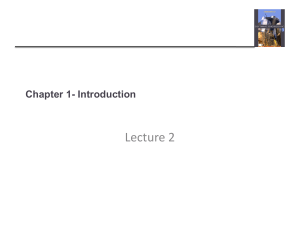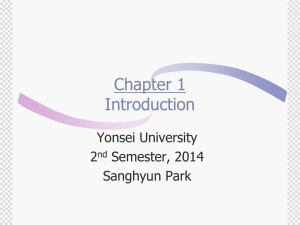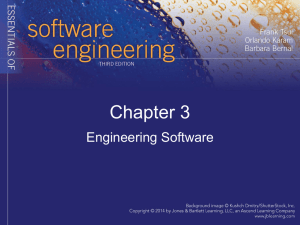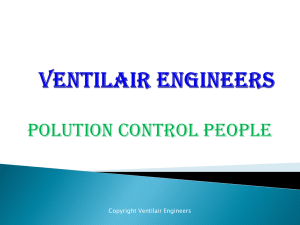lect1-introduction
advertisement
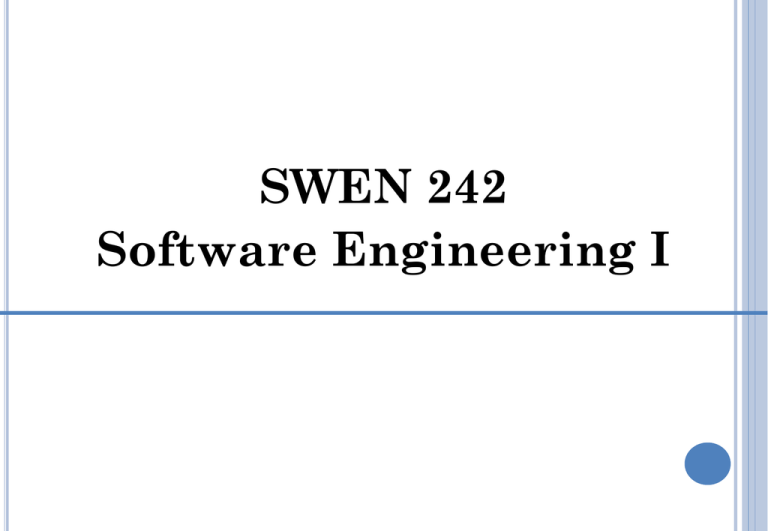
SWEN 242 Software Engineering I • Textbook: Ian Sommerville, Software Engineering, 9th Edition, AddisonWesley, 2011 http://tech.groups.yahoo.com/group/NP_SWENGI/ EVALUATION • • • • • • Final Examination: Midterm Examination: Assignments: Unannounced Quizzes: Project Attendance &class work 40% 25% 10% 10% 10% ± 5% OBJECTIVES Provide the student with an understanding of the Software requirements Provide the student with an understanding of the requirements modeling Teach the student how to analyze and compare different techniques for requirements modeling. Train the student to share ideas and work in a team effectively and independently. TABLE OF CONTENT Introduction Software processes life-cycle Software requirements Requirements modeling Requirements analysis Scenario-based modeling Software Requirements Specification CASE tools for software engineering Software process models WHAT IS SOFTWARE? Computer programs and associated documentation such as requirements, design models and user manuals. Software products may be developed for a particular customer or may be developed for a general market. Software products may be Generic - developed to be sold to a range of different customers e.g. PC software such as Excel or Word. Custom - developed for a single customer according to their specification. E.g. embedded control systems, air traffic control software, traffic monitoring systems New software can be created by developing new programs, configuring generic software systems or reusing existing software. WHAT IS SOFTWARE ENGINEERING? Software engineering is an engineering discipline that is concerned with all aspects of software production. Software engineers should adopt a systematic and organised approach to their work and use appropriate tools and techniques depending on the problem to be solved, the development constraints and the resources available. WHAT IS THE DIFFERENCE BETWEEN SOFTWARE ENGINEERING AND COMPUTER SCIENCE? Computer science is concerned with theory and fundamentals; software engineering is concerned with the practicalities of developing and delivering useful software. Computer science theories are still insufficient to act as a complete underpinning for software engineering (unlike e.g. physics and electrical engineering). WHAT IS THE DIFFERENCE BETWEEN SOFTWARE ENGINEERING AND SYSTEM ENGINEERING? System engineering is concerned with all aspects of computer-based systems development including hardware, software and process engineering. Software engineering is part of this process concerned with developing the software infrastructure, control, applications and databases in the system. System engineers are involved in system specification, architectural design, integration and deployment. THE ROLE FOR SOFTWARE ENGINEERING IMPORTANCE OF SOFTWARE ENGINEERING More and more, individuals and society rely on advanced software systems. We need to be able to produce reliable and trustworthy systems economically and quickly. It is usually cheaper, in the long run, to use software engineering methods and techniques for software systems rather than just write the programs as if it was a personal programming project. For most types of system, the majority of costs are the costs of changing the software after it has gone into use. WHAT IS A SOFTWARE PROCESS? A set of activities whose goal is the development or evolution of software. Generic activities in all software processes are: Specification - what the system should do and its development constraints Development - production of the software system Validation - checking that the software is what the customer wants Evolution - changing the software in response to changing demands. WHAT IS A SOFTWARE PROCESS MODEL? A simplified representation of a software process, presented from a specific perspective. Examples of process perspectives are Workflow perspective - sequence of activities; Data-flow perspective - information flow; Role/action perspective - who does what. Generic process models Waterfall; Iterative development; Component-based software engineering. WHAT ARE THE COSTS OF SOFTWARE ENGINEERING? Roughly 60% of costs are development costs, 40% are testing costs. For custom software, evolution costs often exceed development costs. Costs vary depending on the type of system being developed and the requirements of system attributes such as performance and system reliability. Distribution of costs depends on the development model that is used. WHAT ARE SOFTWARE ENGINEERING METHODS? Structured approaches to software development which include system models, notations, rules, design advice and process guidance. Model descriptions: Descriptions of graphical models which should be produced; Rules: Constraints applied to system models; Recommendations: Advice on good design practice; Process guidance: What activities to follow. WHAT IS CASE (COMPUTER-AIDED SOFTWARE ENGINEERING) Software systems that are intended to provide automated support for software process activities. CASE systems are often used for method support. Upper-CASE Tools to support the early process activities of requirements and design; Lower-CASE Tools to support later activities such as programming, debugging and testing. WHAT ARE THE ATTRIBUTES SOFTWARE? OF GOOD The software should deliver the required functionality and performance to the user and should be maintainable, dependable and acceptable. Maintainability: Software must evolve to meet changing needs; Dependability: Software must be trustworthy; Efficiency: Software should not make wasteful use of system resources; Acceptability : Software must accepted by the users for which it was designed. This means it must be understandable, usable and compatible with other systems. WHAT ARE THE KEY CHALLENGES FACING SOFTWARE ENGINEERING? Heterogeneity Developing techniques for building software that can cope with heterogeneous platforms and execution environments; Delivery Developing techniques that lead to faster delivery of software; Trust Developing techniques that demonstrate that software can be trusted by its users. APPLICATION TYPES Batch processing systems : Business systems that are designed to process data in large batches, they process large numbers of individual inputs to create corresponding outputs. Entertainment systems : These are systems that are primarily for personal use and which are intended to entertain the user. Systems for modeling and simulation : Systems that are developed by scientists and engineers to model physical processes or situations. Data collection systems : Systems that collect data from their environment using a set of sensors and send that data to other systems for processing. Systems of systems : Systems that are composed of a number of other software systems. SOFTWARE ENGINEERING FUNDAMENTALS Some fundamental principles apply to all types of software system, irrespective of the development techniques used: Systems should be developed using a managed and understood development process. Dependability and performance are important for all types of system. Understanding and managing the software specification and requirements (what the software should do) are important. Where appropriate, you should reuse software that has already been developed rather than write new software. SOFTWARE ENGINEERING AND THE WEB The Web is now a platform for running application and organizations are increasingly developing web-based systems rather than local systems. Web services allow application functionality to be accessed over the web. Web software engineering Software reuse is the dominant approach for constructing web-based systems. Web-based systems should be developed and delivered incrementally WEB SOFTWARE ENGINEERING User interfaces are constrained by the capabilities of web browsers. Web-based systems are complex distributed systems but the fundamental principles of software engineering discussed previously are as applicable to them as they are to any other types of system. The fundamental ideas of software engineering, discussed in the previous section, apply to web-based software in the same way that they apply to other types of software system. PROFESSIONAL AND ETHICAL RESPONSIBILITY Software engineering involves wider responsibilities than simply the application of technical skills. Software engineers must behave in an honest and ethically responsible way if they are to be respected as professionals. Ethical behaviour is more than simply upholding the law. ISSUES OF PROFESSIONAL RESPONSIBILITY Confidentiality : Engineers should normally respect the confidentiality of their employers or clients irrespective of whether or not a formal confidentiality agreement has been signed. Competence : Engineers should not misrepresent their level of competence. Intellectual property rights : Engineers should be aware of local laws governing the use of intellectual property such as patents, copyright, etc. They should be careful to ensure that the intellectual property of employers and clients is protected. Computer misuse : Software engineers should not use their technical skills to misuse other people’s computers. Computer misuse ranges from relatively trivial (game playing) to extremely serious (dissemination of viruses). ACM/IEEE CODE OF ETHICS The professional societies in the US have cooperated to produce a code of ethical practice. Members of these organisations sign up to the code of practice when they join. The Code contains eight Principles related to the behaviour of and decisions made by professional software engineers, including practitioners, educators, managers, supervisors and policy makers, as well as trainees and students of the profession. CODE OF ETHICS - PRINCIPLES Software engineers shall commit themselves to making the analysis, specification, design, development, testing and maintenance of software a beneficial and respected profession. In accordance with their commitment to the health, safety and welfare of the public, software engineers shall adhere to the following Eight Principles: 1- PUBLIC : Software engineers shall act consistently with the public interest. 2- CLIENT AND EMPLOYER : Software engineers shall act in a manner that is in the best interests of their client and employer consistent with the public interest. CODE OF ETHICS - PRINCIPLES 3- PRODUCT : Software engineers shall ensure that their products and related modifications meet the highest professional standards possible. 4- JUDGMENT : Software engineers shall maintain integrity and independence in their professional judgment. 5- MANAGEMENT : Software engineering managers and leaders shall subscribe to and promote an ethical approach to the management of software development and maintenance. CODE OF ETHICS - PRINCIPLES 6- PROFESSION : Software engineers shall advance the integrity and reputation of the profession consistent with the public interest. 7- COLLEAGUES : Software engineers shall be fair to and supportive of their colleagues. 8- SELF : Software engineers shall participate in lifelong learning regarding the practice of their profession and shall promote an ethical approach to the practice of the profession. ETHICAL DILEMMAS Disagreement in principle with the policies of senior management. Your employer acts in an unethical way and releases a safety-critical system without finishing the testing of the system. Participation in the development of military weapons systems or nuclear systems. CASE STUDIES A personal insulin pump An embedded system in an insulin pump used by diabetics to maintain blood glucose control. A mental health case patient management system A system used to maintain records of people receiving care for mental health problems. A wilderness weather station A data collection system that collects data about weather conditions in remote areas. INSULIN PUMP CONTROL SYSTEM Collects data from a blood sugar sensor and calculates the amount of insulin required to be injected. Calculation based on the rate of change of blood sugar levels. Sends signals to a micro-pump to deliver the correct dose of insulin. ACTIVITY MODEL OF THE INSULIN PUMP A PATIENT INFORMATION SYSTEM FOR MENTAL HEALTH CARE A patient information system to support mental health care is a medical information system that maintains information about patients suffering from mental health problems and the treatments that they have received. Most mental health patients do not require dedicated hospital treatment but need to attend specialist clinics regularly where they can meet a doctor who has detailed knowledge of their problems. To make it easier for patients to attend, these clinics are not just run in hospitals. They may also be held in local medical practices or community centres. MHC-PMS GOALS To generate management information that allows health service managers to assess performance against local and government targets. To provide medical staff with timely information to support the treatment of patients. MHC-PMS KEY FEATURES Individual care management Patient monitoring Clinicians can create records for patients, edit the information in the system, view patient history, etc. The system supports data summaries so that doctors can quickly learn about the key problems and treatments that have been prescribed. The system monitors the records of patients that are involved in treatment and issues warnings if possible problems are detected. Administrative reporting The system generates monthly management reports showing the number of patients treated at each clinic, the number of patients who have entered and left the care system, number of patients sectioned, the drugs prescribed and their costs, etc. MHC-PMS CONCERNS Privacy It is essential that patient information is confidential and is never disclosed to anyone apart from authorised medical staff and the patient themselves. Safety Some mental illnesses cause patients to become suicidal or a danger to other people. Wherever possible, the system should warn medical staff about potentially suicidal or dangerous patients. The system must be available when needed otherwise safety may be compromised and it may be impossible to prescribe the correct medication to patients. WILDERNESS WEATHER STATION The government of a country with large areas of wilderness decides to deploy several hundred weather stations in remote areas. Weather stations collect data from a set of instruments that measure temperature and pressure, sunshine, rainfall, wind speed and wind direction. The weather station includes a number of instruments that measure weather parameters such as the wind speed and direction, the ground and air temperatures, the barometric pressure and the rainfall over a 24-hour period. Each of these instruments is controlled by a software system that takes parameter readings periodically and manages the data collected from the instruments. Chapter 1 Introduction 38 THE WEATHER STATION’S ENVIRONMENT WEATHER INFORMATION SYSTEM The weather station system : This is responsible for collecting weather data, carrying out some initial data processing and transmitting it to the data management system. The data management and archiving system : This system collects the data from all of the wilderness weather stations, carries out data processing and analysis and archives the data. The station maintenance system : This system can communicate by satellite with all wilderness weather stations to monitor the health of these systems and provide reports of problems. ADDITIONAL SOFTWARE FUNCTIONALITY Monitor the instruments, power and communication hardware and report faults to the management system. Manage the system power, ensuring that batteries are charged whenever the environmental conditions permit but also that generators are shut down in potentially damaging weather conditions, such as high wind. Support dynamic reconfiguration where parts of the software are replaced with new versions and where backup instruments are switched into the system in the event of system failure.
